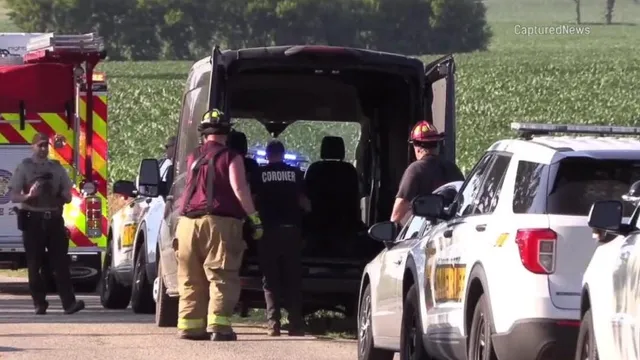
Two people die in small plane crash in Illinois cornfield
2025-06-28 19:51- A small plane crash in a cornfield in Capron, Illinois, resulted in the deaths of two people.
- The incident was reported around 3:20 p.m. and the victims have not yet been identified.
- The National Transportation Safety Board is conducting an investigation into the cause of the crash.
Express your sentiment!
Insights
On Saturday afternoon, June 28, 2025, a tragic plane crash occurred in Boone County, Illinois, claiming the lives of two individuals. The crash site was discovered in a cornfield located near Capron and Blaine roads, approximately 90 miles northwest of Chicago and close to the Wisconsin border. Boone County Sheriff Scott Yunk reported that deputies arrived on the scene around 3:20 p.m. after receiving a notification about the crash. A local farmer assisted the authorities in locating the wreckage of the plane, which was confirmed to be a Vans RV-10 single-engine propeller aircraft. The investigation into the crash is being handled by the National Transportation Safety Board, which is working to gather more details surrounding the incident. At this time, the identities of the victims have not been released pending notification of their families. The circumstances leading to the crash remain unclear; officials have not yet established the flight's departure point or final destination. Moreover, records from the Federal Aviation Administration indicate that the plane is registered in Grayslake, Illinois, which is about 45 miles to the east of where the accident occurred. As authorities continue to investigate, the community is left grappling with the sudden loss of life. The unpredictability of aviation accidents poses ongoing questions about safety measures and protocols in place for general aviation. This incident is particularly significant considering that small planes, while generally regarded as safe, experience crashes that can result in severe outcomes. The Vans RV-10, which is known for its sturdy design and performance among recreational pilots, emphasizes the need for thorough flight planning and adherence to safety regulations. The National Transportation Safety Board's inquiry will look into whether any mechanical failures or human errors could have contributed to this crash. Both the victims’ families and the broader community are hoping for transparent communication from the investigation, which will hopefully lead to answers about this unfortunate event. Investigations such as these often require time to sift through multiple data points, including aircraft maintenance records, pilot qualifications, and flight paths. The lessons learned from such incidents are critical to enhancing aviation safety moving forward.
Contexts
Aviation safety measures for small planes are paramount for ensuring the security and well-being of both pilots and passengers. Small aircraft, while less complex than commercial airliners, are subject to unique risk factors that necessitate stringent safety protocols. In recent years, advancements in technology and the implementation of best practice guidelines have led to significant improvements in small plane safety. However, the aviation community must continue to prioritize safety to combat fatalities and accidents associated with general aviation. A multifaceted approach, including training, maintenance, and technological enhancements, is essential for improving safety outcomes. Pilot training is a critical component of aviation safety in small aircraft operations. Comprehensive training programs that focus not only on technical flying skills but also on emergency response and decision-making under stress can greatly reduce the likelihood of accidents. Training should include simulated scenarios that mimic real-world emergencies, equipping pilots with the skills necessary to handle unexpected situations. Furthermore, recurrent training and self-assessment programs can help maintain pilot competency throughout their careers. The emphasis on creating a safety culture within aviation organizations leads pilots to prioritize risk management and make informed decisions, ultimately enhancing overall safety. Another vital aspect of aviation safety is the maintenance of small aircraft. Regular inspections and adherence to maintenance schedules are critical in ensuring that aircraft remain in optimal flying condition. The development of standardized maintenance protocols and the use of reliable maintenance personnel can reduce mechanical failures that contribute to accidents. Moreover, the incorporation of advanced diagnostic technologies enables prompt identification of potential issues, ensuring that they are addressed before they result in failure. Aircraft operators must remain diligent in maintaining their fleets to uphold safety standards and should be encouraged to report any irregularities without fear of repercussions. Lastly, the role of technology in boosting aviation safety cannot be overstated. The availability of systems such as Automatic Dependent Surveillance–Broadcast (ADS-B), terrain awareness and warning systems (TAWS), and enhanced ground proximity warning systems (EGPWS) provides pilots with critical information that aids in safe navigation and situational awareness. Innovations in avionics and aircraft design, such as improved aerodynamics and fuel efficiency, contribute to enhanced safety performance. While these technologies are promising, their successful integration into small aircraft operations requires both pilot training and organizational commitment to leverage their full potential. In summary, a comprehensive focus on pilot training, maintenance, and technology is essential for strengthening aviation safety measures for small planes and fostering a culture of safety that benefits the entire aviation community.